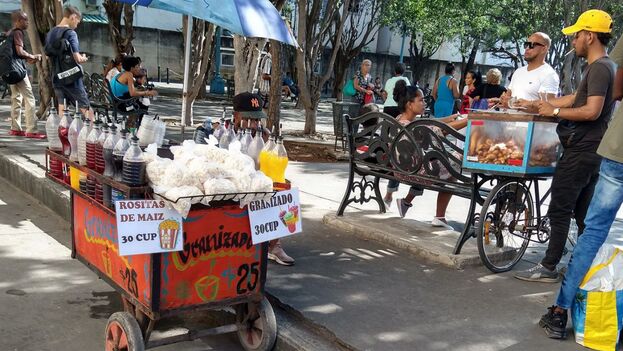
![]() 14ymedio, Natalia López Moya, Havana, 20 December 2022 – At first it quenches the thirst but later you’re left wanting another, and then another. Granizado [English: ’slush’] is the cheapest drink you can get whilst out and about on the streets in Cuba, but in times of inflation even this glass of ice, water and syrup has seen its price arrive at a level beyond the pockets of anyone who only earns the monthly minimum wage.
14ymedio, Natalia López Moya, Havana, 20 December 2022 – At first it quenches the thirst but later you’re left wanting another, and then another. Granizado [English: ’slush’] is the cheapest drink you can get whilst out and about on the streets in Cuba, but in times of inflation even this glass of ice, water and syrup has seen its price arrive at a level beyond the pockets of anyone who only earns the monthly minimum wage.
Known as raspado in other Latin American countries, Cuban granizado has been there for the common people through thick and thin. Consumed with peanuts, this sugared drink was a lifesaver during long hours of waiting for the bus at dawn before any breakfast, and even in the improvised social gatherings on the Malecón in Havana when you didn’t even have the price of a shot of rum.
But even this modest sip has become unrecognisable. In only a decade granizado has become more than ten times more expensive. If a glass of it cost 2 pesos in 2012 now it’s 30 — a price that’s alienated even its most loyal customers: pensioners, those with few resources and adolescents who can’t afford a can of fizzy drink.
On Tuesday morning, a cart selling granizado appeared opposite the steps of the entrance to Havana University. With its range of flavours including strawberry, cola and ice-cream, it was noticeable that no one approached it to cool themselves down in the December heat with a cold sugary drink. Though the price marked on the metal trolley was 25 pesos per freshly poured glass, a paper sign above it now announced that the product had gone up by five pesos.
On the benches nearby dozens of people formed a long queue (line) for the buses, which, increasingly spread out now, line up from Calle San Lázaro. In earlier times they would have hung around and had a granizado first, but most of them are elderly and their pension doesn’t provide them more than 2,000 pesos a month. It’s just too much to spend more than a day’s pension on a coloured squash drink that disappears in three mouthfuls.
The sellers, however, justify the price increase. “No one sells me anything cheaply. I have to get up really early every morning and pay for the the ice at the price that it’s at on the day”. A bag of ice of between 6 and 7 pounds never goes below 80 pesos and “you have to add to that the cost of the syrup and the paper cups”. In order to get hold of the supply of most of these materials one needs to get onto the black market.
The granizado man continues with his list of complaints: “It’s increasingly more expensive for me to keep the cart in a secure place, and then there’s the fines that sometimes I get for selling on some corner where I shouldn’t be, or then some spiteful inspector wants to get money out of me… All this just adds up and adds up”. His story might sound logical enough and try to minimise the rise in prices but it doesn’t manage to change many of his customers’ decisions.
What was a drink to be grabbed in ordinary life for everyday need, to give you a swig and move you on for another half hour, has now been added to the list of things that can no longer be afforded, a bit like it all ended up with a beer, a soft drink or even a bottled water.
Translated by Ricardo Recluso
____________
COLLABORATE WITH OUR WORK: The 14ymedio team is committed to practicing serious journalism that reflects Cuba’s reality in all its depth. Thank you for joining us on this long journey. We invite you to continue supporting us by becoming a member of 14ymedio now. Together we can continue transforming journalism in Cuba.
